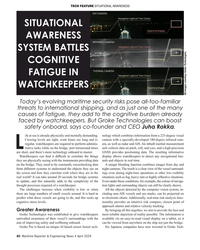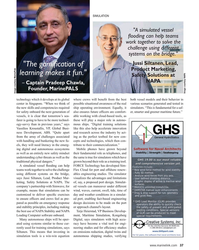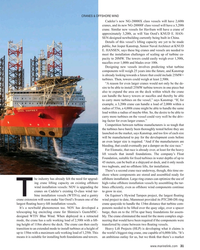High Speed Transportation
-
- Diesel renaissance in Italy Maritime Reporter, Mar 2001 #8
At a time when the South Korean heavyweights have signaled their determination to capture more than 50 percent of the global market for low-speed diesel engines, an Italian renaissance in two-stroke production testifies to a determination in one of the European camps not to bow to oriental industrial ascendancy.
As part of a broad-based manufacturing program encompassing two-stroke and four-stroke designs, the streamlined Trieste plant of Wartsila Italia reported firm contracts, letters of intent and options for 25 Sulzer low-speed engines when your correspondent visited the works during February.
Since the former Grandi Motori Trieste (GMT) plant came under Wartsila management in 1997, followed by Finnish group's 100 percent takeover at the outset of January 1999, major efforts have been put into making the factory competitive on a worldwide basis.
That this has been achieved with a diversified production portfolio, in an era when large-scale manufacturing at any one location is trending towards optimized output of as few products as possible, is a measure of Wartsila's circumspect organizational planning and investment in production technology.
While in-house manufacturing capability is elemental to competitiveness in the four-stroke sector, the Finnish group's recourse to two-stroke building capacity at Trieste provides it with firsthand experience in a field of production otherwise dominated by licensees in the Far East. This type of involvement can only benefit its activities as a driver of two-stroke technology and design development.
Success in building the two-stroke business at Trieste, while reflecting the increased efficiency of the plant and the group's European manufacturing network as a whole, has also been assisted by the recent rise in Far East engine prices, attributable perhaps to huge orderbook commitments The Sulzer low-speed engine orderbook in Trieste includes a high concentration of RTA72U-B units for containership newbuild projects at German yards. It also features the RTA84C design, underscoring the Italian plant's scope for wide-bore machinery, and has recently been boosted with RT-flex common- rail engines booked for a reefer vessel series entrusted to a Portuguese shipbuilder.
Trieste is currently operating at an output level in the region of 500-750 MW per annum, and is a showcase for the Wartsila Flexible Manufacturing System, the production model which has evolved out of the company's 'focused factory' concept. The Italian plant created something of the template for the new system, whereby nominated backup factories support each product-specific factory for engine assembly and component manufacture. Its role in meeting the surging demand for Wartsila 46 medium-speed engines, for which the Turku plant in Finland is the lead producer, is illustrative of the arrangements.
The enduring popularity of the Sulzer ZA40S four-stroke series is clearly in evidence at Trieste, where it contributes substantially to the delivery program through to 2004. The Italian works is also the nominated factory for the Wartsila 26X, aimed at high-speed transportation and naval applications, and for the mighty 64-type four-stroke, the world's most powerful medium-speed diesel, delivering a staggering 2 MW per cylinder. Commencing with the 13,645-dwt German vessel Containerships VI, commissioned in 1999, a total 11 engines of the Wartsila 64 type have now been supplied for marine propulsion.
At press time, the Finnish engine group was hoping that the design would be nominated for an Italian tanker newbuild project, to set a major new phase of diesel production in train at Trieste.
While the largest modern-day diesel, which the plant is currently geared up to produce is the RTA84C in its eightcylinder configuration, the Italian factory has the distinction of having produced the world's biggest diesel engine as measured by bore size. The record was set in 1972 with the delivery of a Fiat two-stroke unit with a bore of 1,060-mm. By comparison, the largest, albeit considerably more powerful, engines now available are of 960 mm and 980 mm-bore, turned out in the Far East under license from Wartsila and MAN B&W, respectively.
-
- Spain: Finding Strength in Specialization Maritime Reporter, Mar 2002 #51
confers a better work distribution throughout the company while better ensuring that newbuild completion dates can be met. IZAR's propensity for the higher value-added categories of newbuild vessel is evident in the composition of the current orderbook. In addition to five LNG carriers and three RoPax
-
 )
March 2024 - Marine Technology Reporter page: 44
)
March 2024 - Marine Technology Reporter page: 44process using the SAS Target in a single work? ow. The sensor’s 360-degree scanner and Assistant. The application runs in the background, leaving us- high collection rate provides a premier solution for mapping ers to focus their mental capacity on the most valuable task coastal infrastructure. The CL-360
-
 )
March 2024 - Marine Technology Reporter page: 42
)
March 2024 - Marine Technology Reporter page: 42CONNECTORS BIRNS made a splash at Oi at the company’s Power Forward event, with the celebration of the company’s 70th anniversary, and the launch of a new high amperage subsea connector se- ries, the 225 Amp BIRNS Meridian line. The Meridian line, a robust, custom engineered dry-mate connector series is open
-
 )
March 2024 - Marine Technology Reporter page: 41
)
March 2024 - Marine Technology Reporter page: 41Image courtesy Outland Technology Image courtesy Exail Image courtesy Submaris and EvoLogics Vehicles The ROV-1500 from Outland Technology represents a leap forward in underwater robotics, a compact remotely operated vehicle (ROV) weighing in at less than 40 lbs (19kg) the ROV- 1500 is easy to transport
-
 )
March 2024 - Marine Technology Reporter page: 39
)
March 2024 - Marine Technology Reporter page: 39solar charging systems on buoys and unmanned surface vehicles (USV). For very low currents, continuous or intermittent, the West Mountain Radio CBA HR (High Resolution) model is designed to test any small battery from 0.7 to 10 volts at load currents of 1 mA to 1000 mA, (10 watt maximum), in increments
-
 )
March 2024 - Marine Technology Reporter page: 38
)
March 2024 - Marine Technology Reporter page: 38to and balance discharged on the same two-wire bus. 2,000 cycles. Self-discharge rate is 20%/month. They have a QUANTIFYING BATTERY CAPACITY reasonably high power-to-weight ratio. The discharge curve of a NiCad battery is ? atter than other batteries. The NiCad The best way to determine a battery’s capacity
-
 )
March 2024 - Marine Technology Reporter page: 36
)
March 2024 - Marine Technology Reporter page: 36on a proach 0°C depending on current drain. Lead acid batteries small ocean lander or AUV by unplugging the spent exterior can provide substantially higher capacities when discharged battery packs and plugging in the replacement charged ones. at a rate lower than 1C. (See Lander Lab #5, MTR, November/Decembe
-
 )
March 2024 - Marine Technology Reporter page: 35
)
March 2024 - Marine Technology Reporter page: 35Figure 1 A self-righting vehicle design with buoyancy high and weight low, WHOI’s SeaBED AUV captures the attention of a pair of curious Antarctic penguins as it is deployed from the British research vessel James Clark Ross. Vehicle designers allowed for temperature reduction of battery capacity. Recharge
-
 )
March 2024 - Marine Technology Reporter page: 30
)
March 2024 - Marine Technology Reporter page: 30FEATURE SEABED MINING bilical. It has passive heave compensation which nulli? es the necott. “The focus since then has been on scaling while en- wave, current and vessel motions that in? uence loads in the suring the lightest environmental impact,” says The Metals power umbilical. The LARS can
-
 )
March 2024 - Marine Technology Reporter page: 29
)
March 2024 - Marine Technology Reporter page: 29that released sedi- ment-laden water led to a low-lying, later- ally spreading turbidity current. Only 2-8% of the sediment mass was detected 2m or higher above the seabed and hadn’t settled after several hours. “All indications to date point to polymetal- lic nodules having the potential to become
-
 )
March 2024 - Marine Technology Reporter page: 18
)
March 2024 - Marine Technology Reporter page: 18, typically every three to ? ve picked up as coating damage. years, or to conduct CP assessments opportunistically when In contrast, a new generation high sensitivity ? eld gradi- in the vicinity. FiGS, however, revolutionizes this process by ent sensor for use on ROVs and AUVs developed by FORCE providing
-
 )
March 2024 - Marine Technology Reporter page: 15
)
March 2024 - Marine Technology Reporter page: 15periods. About the Author For glider users working in ? sheries and conservation, Shea Quinn is the Product Line Manager the Sentinel can run several high-energy passive and active of the Slocum Glider at Teledyne Webb acoustic sensors, on-board processing, and imaging hardware Research. Quinn came
-
 )
March 2024 - Marine Technology Reporter page: 14
)
March 2024 - Marine Technology Reporter page: 14the established piloting, crease mission length to over 2 years; or users can ? t more ? ight control, and communications architecture of the Slocum high-energy sensors like active or passive acoustics, sensors Glider, and allows for the same sensor and hardware options with on-board processing, and
-
 )
March 2024 - Marine Technology Reporter page: 13
)
March 2024 - Marine Technology Reporter page: 13type of platform has seen over ity: longer missions, more sensors – the standard Slocum Glider through an the past two decades, growing from especially high-energy sensors – and increased diameter to gain better volu- emerging technology to one of the most the need to operate in more diverse metric ef
-
 )
March 2024 - Marine Technology Reporter page: 11
)
March 2024 - Marine Technology Reporter page: 11hazard to manned MCM vessels. To safely detect, identify, and classify these mines, AUVs would be deployed from standoff range to scan the seabed using high resolution underwater imaging systems, including sidescan and synthetic aperture sonars, as well as laser scanners. Ukraine is al- ready in possession
-
 )
April 2024 - Maritime Reporter and Engineering News page: 43
)
April 2024 - Maritime Reporter and Engineering News page: 43“The industry is an ecosystem which includes owners, managers, mariners, shipyards, equipment makers, designers, research institutes and class societies: all of them are crucial,” – Eero Lehtovaara, Head of Regulatory & Public Affairs, ABB Marine & Ports All images courtesy ABB Marine and Ports provi
-
 )
April 2024 - Maritime Reporter and Engineering News page: 41
)
April 2024 - Maritime Reporter and Engineering News page: 41. Groke Pro is the ? rst machine vision terest from insurance companies. In Groke Pro was not designed to re- solution to obtain Innovation Endorse- high-risk situations, a recording of im- place crew on board but to provide ment for Products and Solutions from ages is automatically triggered, so Groke
-
 )
April 2024 - Maritime Reporter and Engineering News page: 40
)
April 2024 - Maritime Reporter and Engineering News page: 40and AIS. An inbuilt inertial measurement L trative tasks while on the bridge, port turnaround times unit collects data on pitch, roll, and yaw, and a high-precision are short, and there’s more technology onboard to master. GNSS provides positioning data. The resulting informative Watchkeepers can ?
-
 )
April 2024 - Maritime Reporter and Engineering News page: 39
)
April 2024 - Maritime Reporter and Engineering News page: 39owned by the Danish state, MOL Ship Management Co., Ltd. Scale: 1:25 takes his love of maritime and LEGOs The “Wall Climbing Robot” can move to high Length: 61.5 cm to new heights, creating a LEGO model With: 22.5 cm places that were previously dif? cult to access by Weight: 2.5 kg of the pilot
-
 )
April 2024 - Maritime Reporter and Engineering News page: 37
)
April 2024 - Maritime Reporter and Engineering News page: 37Business Develop- Loading Computer software onboard. ment, Maritime Simulation, Kongsberg Many autonomous ships will be oper- Digital, says simulators with high accu- ated using systems similar to those cur- racy have become a vital tool for engi- rently used for training simulations, says neering studies and
-
 )
April 2024 - Maritime Reporter and Engineering News page: 36
)
April 2024 - Maritime Reporter and Engineering News page: 36FEATURE "Simulators with high "Tomorrow’s seafarer is going accuracy have become a vital to have to be more technology- savvy than in previous years." tool for engineering studies." Image courtesy ABS – Terje Heierstad, VP Business – Vassilios Kroustallis, VP, Global Development, Maritime Business
-
 )
April 2024 - Maritime Reporter and Engineering News page: 32
)
April 2024 - Maritime Reporter and Engineering News page: 32reduces the time it would there won’t be the same downturn in oil and gas that made all ordinarily take, weeks, to recon? gure the wiring of an ordi- the high-spec construction vessels available at attractive rates, nary crane. “Effectively, it can move the foundation in one lift says David Inman, Sales
-
 )
April 2024 - Maritime Reporter and Engineering News page: 31
)
April 2024 - Maritime Reporter and Engineering News page: 31has already felt the need for upgrad- offshore installation. Large ring cranes can optimize the use of ing crane lifting capacity on existing offshore high-value offshore installation vessels by assembling the tur- wind installation vessels: NOV is upgrading the bines ef? ciently, even as offshore wind
-
 )
April 2024 - Maritime Reporter and Engineering News page: 28
)
April 2024 - Maritime Reporter and Engineering News page: 28combined civil service and military crew. Our two ocean going tugs are going to be part of a 10-ship class. We have a special warfare support ship; two high-speed transports; and the high-speed expeditionary fast transport, of which 14 are now in service. We have contractor-owned ships that are em- ployed
-
 )
April 2024 - Maritime Reporter and Engineering News page: 27
)
April 2024 - Maritime Reporter and Engineering News page: 27will be familiar to our Surface detailed world-wide, although some ships like EPF require Force Sailors. We have 14 Henry J. Kaiser-class ? eet replen- high-speed craft (HSC) training. So, MyMSC will help track ishment oilers and three of the new John Lewis class of ? eet and manage all of those different
